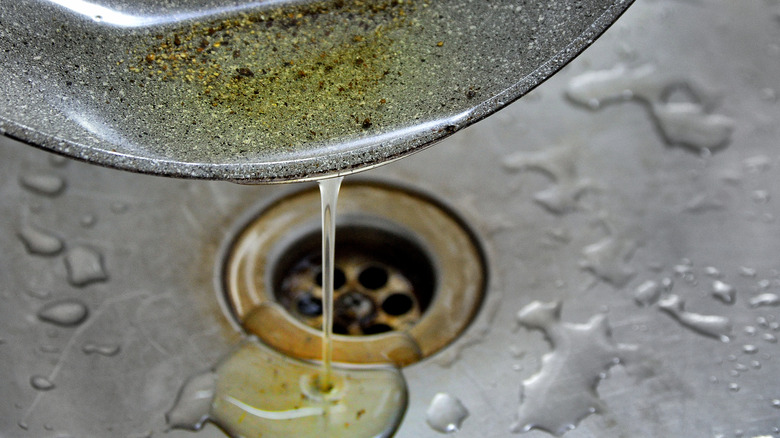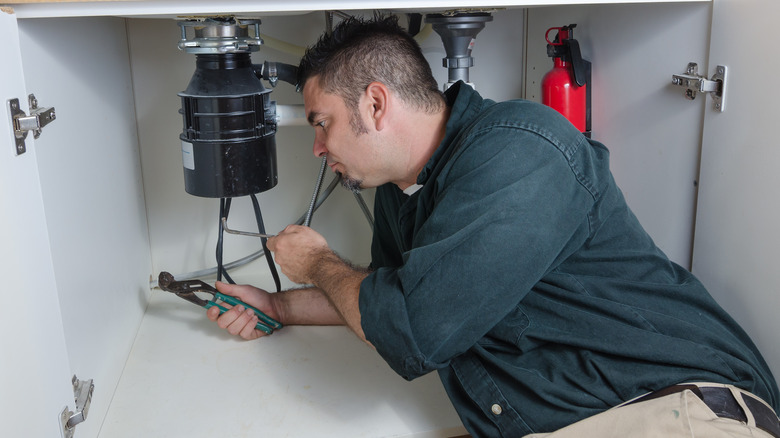This Is What Happens When You Put Onions Down Your Garbage Disposal
Discovering that your garbage disposal isn't working can be a real bummer, but it has happened to just about everyone at some point or another. You flip on your garbage disposal and hear a slight humming noise or a loud grinding — both signs that things are not working as they should. While you're likely already aware of the dangers of dropping foreign objects like silverware, there are also many foods that can also harm your disposal, and most families use them just about every day. These include coffee grounds, meat, starches, shells, nuts, and other fibrous foods, per AHS.
Another food you may not have considered harmful to your disposal is onions. Or, to be specific, onion peels. In fact, a large number of any type of vegetable peels can damage your garbage disposal. If your disposal hasn't been working like it used to, onion skin could be the culprit. It's important to know what onion peels, and other foods, can do to your disposal, and how you can fix your disposal yourself.
How onions, and other foods, can harm your disposal
While your disposal can handle the inner layers, the outer layers should be thrown into the trash can. This is because onion skin is thin and could wrap around your disposal's blades. The skin could also travel past the blades and get stuck further down your drain, which could eventually cause a clog, warns Shiny Modern.
Just like onion peels, there are other foods that can harm the garbage disposal. AHS says that coffee grounds can clump together and clog the drain. Meat can stick to the sides of the disposal and rot, which can cause a gross stench. Starchy foods, like bread, pasta, rice, and oatmeal, should just be thrown into the trash can, because they get sticky and can expand in water, which could clog the system. Shells and nuts can dull the blades or clog the machine. Fibrous foods, like asparagus, celery, pumpkin, and artichokes, are stringy, and the fibers can get tangled in the blades.
Finally, Consumer Reports says that fats, oils, and grease should never be poured down the garbage disposal, or any drain, because they can cause clogs. Surprisingly, peanut butter, ice cream, and heavy cream are also included in the FOG category. However, sometimes pouring a little bit of greasy food down the drain is unavoidable. If you must, use cold water, as it will cause the grease to clump and solidify and can then be broken up by the disposal blades.
How to fix a disposal
According to The Manual, the average cost to fix your garbage disposal is $250. If your system gets clogged often, this occasional expense could add up fast To save some money, you may want to DIY. Here are some tips to fix the garbage disposal yourself.
Before attempting any of these methods, make sure your power and water are turned off. According to the Art of Manliness, the first thing you will want to do is feel around the top of the disposal (with gloves) to see if anything is caught. If you don't find anything, move instead to the hexagon-shaped indentation under the machine. Using a hex key or Allen wrench, spin the blades manually, then check if the obstruction has come loose above. If that doesn't work, you'll have to disconnect the plumbing and use a wire brush to remove the clog. Once you've succeeded, be sure to turn the disposal back on by hitting a safety button on the bottom of the machine. You could also try pouring a natural cleaner down the drain, per The Manual. Mix ½ cup of vinegar and ¼ cup of baking soda and pour it down. After about 15 minutes, you can run hot water down the drain to rinse everything away.


